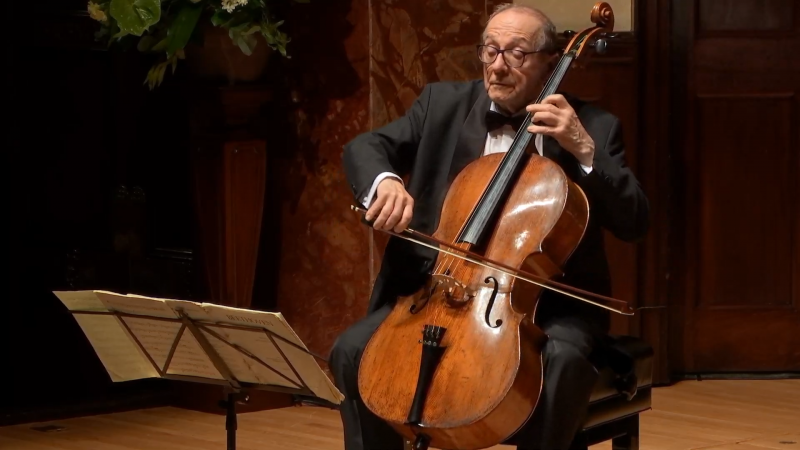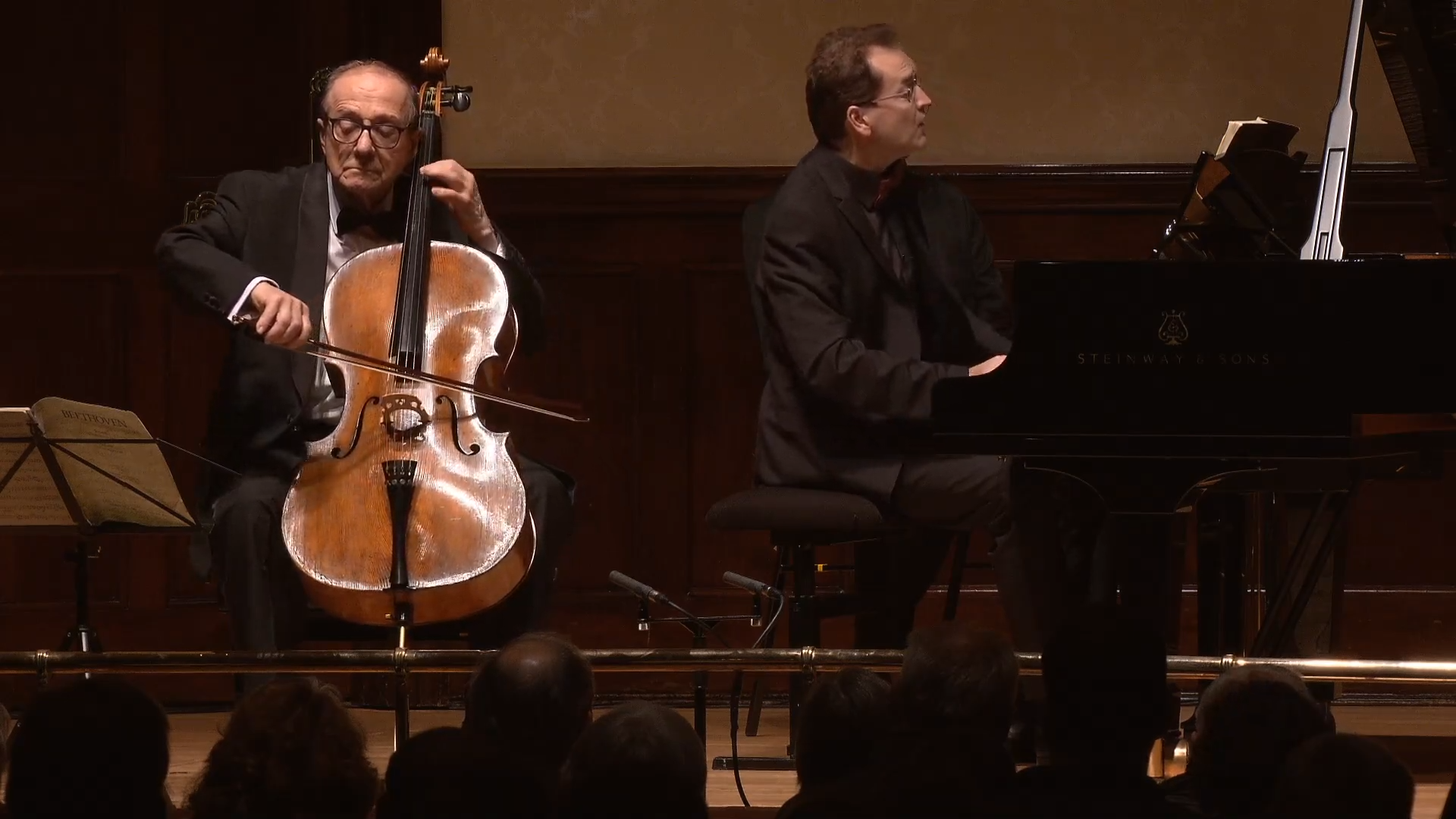Miklós Perényi, Dénes Várjon, Wigmore Hall review – Beethoven in wonderfully safe hands | reviews, news & interviews
Miklós Perényi, Dénes Várjon, Wigmore Hall review – Beethoven in wonderfully safe hands
Miklós Perényi, Dénes Várjon, Wigmore Hall review – Beethoven in wonderfully safe hands
Total authority with the freedom and the feel of improvisation

"Revelatory": it’s one of those words which is now completely devalued through having been carelessly dropped into a thousand press releases.
The Hungarian cellist has an unshakable sense of mission. He stays as literal and as close as he can to Beethoven’s musical intentions, and the trust which he places in the works always seems to find a perfect justification. Now aged 71, Perényi has lived with these all of pieces for most of his life. He recorded them with Dezső Ránki in 1979, again with András Schiff in 2004, but nonetheless chooses to keep his well-worn copies of the cello part on the music stand in front of him. It is as if he never wants to gives up the quest to find yet more of the truth buried in those pages.
These are the kind of evenings when the Wigmore cloakroom is crammed with cello cases, when musicians from several generations watch and listen, their mouths agape in wonder. Perényi plays with total authority, but Beethoven’s spirit of improvisation, of "phantasieren" is ever-present as well. His tone is beautiful and focussed, but he never over-projects. And the achievement of balance between the instruments, the audibility of everything even with the lid of the Steinway up, the common sense of how to articulate phrases as they pass back and forth from player to player – such things are never in doubt.
Steven Isserlis has written of Beethoven’s cello sonatas that they are “a journey through a life”, representing all of Beethoven's three major creative periods. And perhaps the greatest sense of the miraculous that comes from having attended these two evenings at Wigmore Hall is the depth of understanding and the intrinsic feel that Perényi and his compatriot, the fabulous pianist Dénes Várjon (the two pictured below) have for the transformations in Beethoven’s compositional style and methods between 1796 when the first two sonatas and two sets of variations were written, and 1815 the year of the Op. 102 Sonatas. In the Op. 5 Sonatas, and particularly in the second one performed on the Saturday, what was most striking was the clarity of the melodic line from both players in the opening adagio sostenuto, and then the way they both allowed sparseness and lengthening silences to take over, as music the naturally slowed down, preparing the way to enter the ensuing allegro. And that movement when it came, was played with such a sense of unbridled exuberance, it made me think that Mendelssohn must have surely known this work and had it in mind when he wrote his joyous D major Sonata some 45 years later. Here we had Beethoven’s enjoyment, and Várjon's facility and fluency in the faster passages was breathtaking. As biographer Jan Swafford has written of these pieces: “in writing sonatas for cello and piano, Beethoven had a genre virtually to himself.”
In the Op. 5 Sonatas, and particularly in the second one performed on the Saturday, what was most striking was the clarity of the melodic line from both players in the opening adagio sostenuto, and then the way they both allowed sparseness and lengthening silences to take over, as music the naturally slowed down, preparing the way to enter the ensuing allegro. And that movement when it came, was played with such a sense of unbridled exuberance, it made me think that Mendelssohn must have surely known this work and had it in mind when he wrote his joyous D major Sonata some 45 years later. Here we had Beethoven’s enjoyment, and Várjon's facility and fluency in the faster passages was breathtaking. As biographer Jan Swafford has written of these pieces: “in writing sonatas for cello and piano, Beethoven had a genre virtually to himself.”
From Beethoven’s three sets of variations for cello and piano, other very strong impressions stay strongly in mind. From the “Bei Männern” set played on the Saturday, it was the constantly shifting moods that Várjon conjured up, and also the ease with which both players recall old dance forms, and the Ländler in particular. And from the “Ein Mädchen oder Weibchen” set on the Thursday, it was the ways that both players manage to achieve complete rhythmic flexibility and yet find total accord. The tune and almost all the variations build towards the slight ‘wait’, the introduction to the rhythmic flow at the start of bar 14, after which the players find each other and play the song form out. Várjon would sometimes look around and smile. And then the two players would infalliblty find the tempo, land and finish the tune together, without the trick ever seeming either repetitive or mannered.
The sense of our being brought closer as listeners to the works was there in the Op. 102 sonatas as well. Their constant feel of exploring, Beethoven’s wish to create harmonic and rhythmic uncertainty that was to the fore, as well as fixations on short rhythmic patterns. There seems as yet to be very little Beethoven in Várjon’s discography; surely that needs to be put right.
Perhaps the happiest revelations came in the A major Sonata, Op. 69. I don’t think I have ever heard such a vivid demonstration of how sonata form with two contrasted subjects can be made to work and to justify itself. Perényi and Várjon brought out the untroubled pleasures of the lyrical line of the first subject, and then, with equal relish, goaded and accented the off-beats of the second subject. Both evenings finished with the same music: the final movement of the A major sonata was programmed as the last work on the Thursday and played as the only encore on the Saturday. It worked wonderfully because the players, having revelled in the movement’s harmonic meanderings and uncertainty, made the conclusion, the landing back in the home key all the more emphatic and satisfying.
Beethoven's 250th birthday may still be fourteen months away, and the classical music industry’s programming-by-numbers bandwagon is not yet properly rolling, but a pair of concerts as sublime as these don’t actually need that excuse. And hats off to whoever had the idea, the foresight and sorted out the permissions to have both concerts livestreamed and made available on YouTube.
rating
Share this article
The future of Arts Journalism
You can stop theartsdesk.com closing!
We urgently need financing to survive. Our fundraising drive has thus far raised £49,000 but we need to reach £100,000 or we will be forced to close. Please contribute here: https://gofund.me/c3f6033d
And if you can forward this information to anyone who might assist, we’d be grateful.

Subscribe to theartsdesk.com
Thank you for continuing to read our work on theartsdesk.com. For unlimited access to every article in its entirety, including our archive of more than 15,000 pieces, we're asking for £5 per month or £40 per year. We feel it's a very good deal, and hope you do too.
To take a subscription now simply click here.
And if you're looking for that extra gift for a friend or family member, why not treat them to a theartsdesk.com gift subscription?
more Classical music
 Jansen, LSO, Pappano, Barbican review - profound and bracing emotional workouts
Great soloist, conductor and orchestra take Britten and Shostakovich to the edge
Jansen, LSO, Pappano, Barbican review - profound and bracing emotional workouts
Great soloist, conductor and orchestra take Britten and Shostakovich to the edge
 Jakub Hrůša and Friends in Concert, Royal Opera review - fleshcreep in two uneven halves
Bartók kept short, and a sprawling Dvořák choral ballad done as well as it could be
Jakub Hrůša and Friends in Concert, Royal Opera review - fleshcreep in two uneven halves
Bartók kept short, and a sprawling Dvořák choral ballad done as well as it could be
 Hadelich, BBC Philharmonic, Storgårds, Bridgewater Hall, Manchester review - youth, fate and pain
Prokofiev in the hands of a fine violinist has surely never sounded better
Hadelich, BBC Philharmonic, Storgårds, Bridgewater Hall, Manchester review - youth, fate and pain
Prokofiev in the hands of a fine violinist has surely never sounded better
 Monteverdi Choir, ORR, Heras-Casado, St Martin-in-the-Fields review - flames of joy and sorrow
First-rate soloists, choir and orchestra unite in a blazing Mozart Requiem
Monteverdi Choir, ORR, Heras-Casado, St Martin-in-the-Fields review - flames of joy and sorrow
First-rate soloists, choir and orchestra unite in a blazing Mozart Requiem
 Cho, LSO, Pappano, Barbican review - finely-focused stormy weather
Chameleonic Seong-Jin Cho is a match for the fine-tuning of the LSO’s Chief Conductor
Cho, LSO, Pappano, Barbican review - finely-focused stormy weather
Chameleonic Seong-Jin Cho is a match for the fine-tuning of the LSO’s Chief Conductor
 Classical CDs: Shrouds, silhouettes and superstition
Cello concertos, choral collections and a stunning tribute to a contemporary giant
Classical CDs: Shrouds, silhouettes and superstition
Cello concertos, choral collections and a stunning tribute to a contemporary giant
 Appl, Levickis, Wigmore Hall review - fun to the fore in cabaret and show songs
A relaxed evening of light-hearted fare, with the accordion offering unusual colours
Appl, Levickis, Wigmore Hall review - fun to the fore in cabaret and show songs
A relaxed evening of light-hearted fare, with the accordion offering unusual colours
 Lammermuir Festival 2025, Part 2 review - from the soaringly sublime to the zoologically ridiculous
Bigger than ever, and the quality remains astonishingly high
Lammermuir Festival 2025, Part 2 review - from the soaringly sublime to the zoologically ridiculous
Bigger than ever, and the quality remains astonishingly high
 BBC Proms: Ehnes, Sinfonia of London, Wilson review - aspects of love
Sensuous Ravel, and bittersweet Bernstein, on an amorous evening
BBC Proms: Ehnes, Sinfonia of London, Wilson review - aspects of love
Sensuous Ravel, and bittersweet Bernstein, on an amorous evening
 Presteigne Festival 2025 review - new music is centre stage in the Welsh Marches
Music by 30 living composers, with Eleanor Alberga topping the bill
Presteigne Festival 2025 review - new music is centre stage in the Welsh Marches
Music by 30 living composers, with Eleanor Alberga topping the bill
 Lammermuir Festival 2025 review - music with soul from the heart of East Lothian
Baroque splendour, and chamber-ensemble drama, amid history-haunted lands
Lammermuir Festival 2025 review - music with soul from the heart of East Lothian
Baroque splendour, and chamber-ensemble drama, amid history-haunted lands
 BBC Proms: Steinbacher, RPO, Petrenko / Sternath, BBCSO, Oramo review - double-bill mixed bag
Young pianist shines in Grieg but Bliss’s portentous cantata disappoints
BBC Proms: Steinbacher, RPO, Petrenko / Sternath, BBCSO, Oramo review - double-bill mixed bag
Young pianist shines in Grieg but Bliss’s portentous cantata disappoints

Add comment